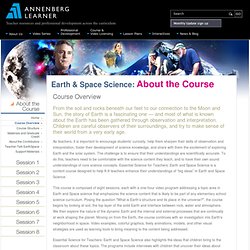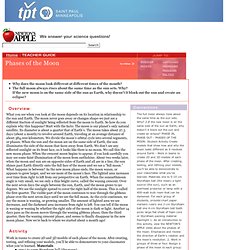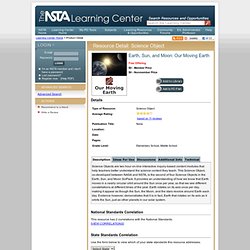

Earth and Space Science. Course Overview From the soil and rocks beneath our feet to our connection to the Moon and Sun, the story of Earth is a fascinating one — and most of what is known about the Earth has been gathered through observation and interpretation.

Children are careful observers of their surroundings, and try to make sense of their world from a very early age. As teachers, it is important to encourage students’ curiosity, help them sharpen their skills of observation and interpretation, foster their development of science knowledge, and share with them the excitement of exploring Earth and the solar system. The challenge is to ensure that their understandings are scientifically accurate. To do this, teachers need to be comfortable with the science content they teach, and to have their own sound understandings of core science concepts. Essential Science for Teachers: Earth and Space Science also highlights the ideas that children bring to the classroom about these topics.
Session Descriptions. Extreme Planet Makeover. Astroventure. Newton's Apple : Teacher Guide. Overview What you see when you look at the moon depends on its location in relationship to the sun and Earth.

The moon never goes away or changes shape-we just see a different fraction of sunlight being reflected from the moon to Earth. So how do you explain why this happens? Start with the facts: The moon is our planet's only natural satellite. Its diameter is about a quarter that of Earth's. Activity Work in teams to create 2D and 3D models of each phase of the moon. For each group of students, provide: chart paper markers rulers one 2cm Styrofoam ball one 4cm Styrofoam ball toothpicks large flat sheet of foam core or Styrofoam packing material flashlight 1. 3.
Resources. Mission:Science. NSTA Learning Center. Description Science Objects are two hour on-line interactive inquiry-based content modules that help teachers better understand the science content they teach.

This Science Object, co-developed between NASA and NSTA, is the second of four Science Objects in the Earth, Sun, and Moon SciPack. It provides an understanding of how we know that Earth moves in a nearly circular orbit around the Sun once per year, so that we see different constellations at different times of the year. Earth rotates on its axis once per day, making it appear as though the Sun, the Moon, and the stars revolve around Earth each day. Evidence however, demonstrates that it is in fact, Earth that rotates on its axis as it orbits the Sun, just as other planets in our solar system.
Additional Info Technical State Standards Correlation Use the form below to view which of your state standards this resource addresses. Loading... Lesson0047. As our highlighted lesson, the submitter was awarded a $50 honorarium.

See our guidelines to submit yours! Life on Mars VaReane Heese, from Springfield Elementary School, Springfield, Nebraska submitted this week's lesson plan that takes a look at the question: "Could there be life on Mars? " Brief Description Scientists believe that Mars once supported life. Objectives Students improve skills in summarizing, predicting, and inferring; work cooperatively to explain a theory; and learn to conduct research online and consult with online experts. Khan Academy. Planet Lesson Plan Grades 5-6. Solar_Sys_Beads. Planet Lesson Plan Grades 5-6. Solar System Scope. Astronomy For Kids - KidsAstronomy.com. NASA - Home. 3D Model of Earth. The-structure-of-the-sun. Education.ohio.gov/getattachment/Topics/Academic-Content-Standards/Science/Grades-K-8-Science-Standards-and-Model-Curriculum-Nov-2012.pdf.